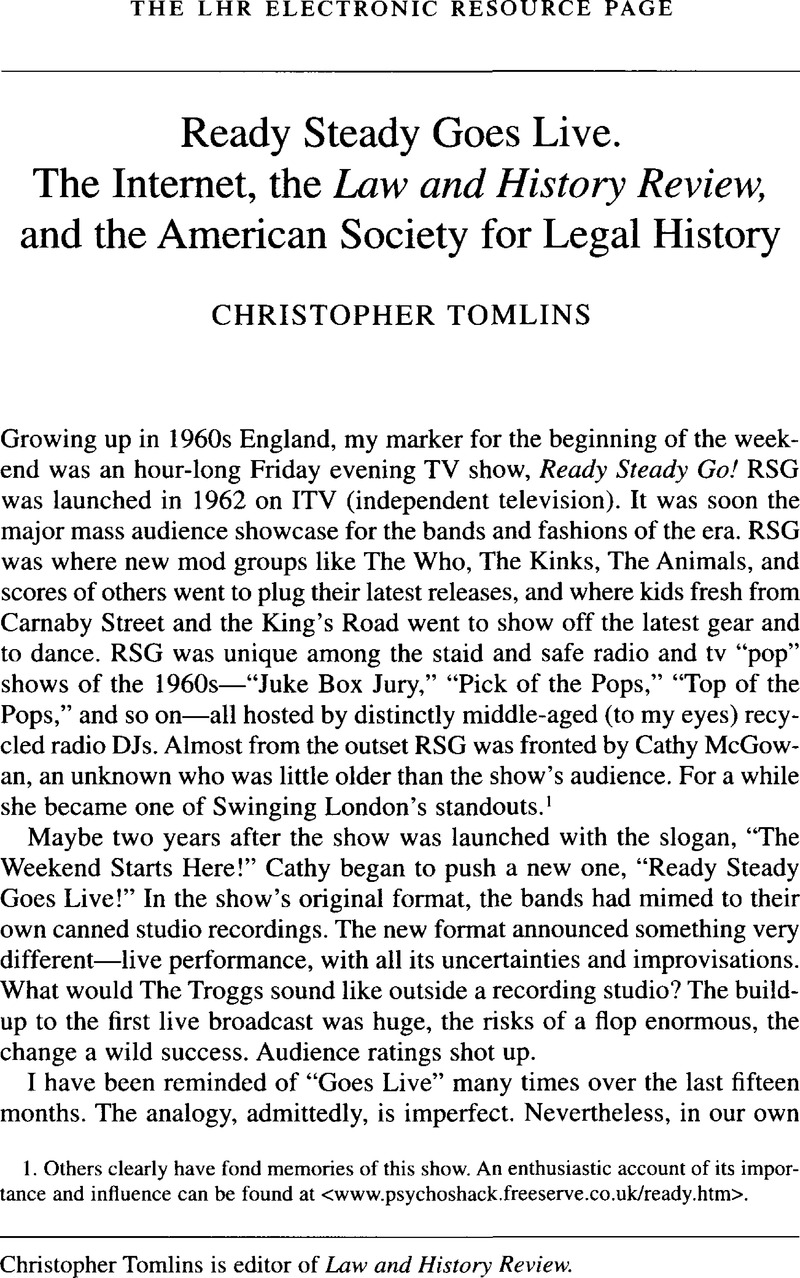No CrossRef data available.
Published online by Cambridge University Press: 28 October 2011

1. Others clearly have fond memories of this show. An enthusiastic account of its importance and influence can be found at <www.psychoshack.freeserve.co.uk/ready.htm>.
2. For an extended introduction to the History Cooperative, go to <www.historycooperative.org/info.html>.
3. The Cooperative proposes to add up to seven leading history journals with common aims and standards each year, both U.S. and international. In each case the Cooperative will produce an electronic edition of the journal, making it available to all subscribers. The Cooperative will accumulate and archive a fully searchable backset of each journal's electronic edition, and the backsets will be cross-searchable. For further information, see “frequently asked questions” at <http://www.historycooperative.org/faq.html>. For a more complete account of the Cooperative Project and its implementation, see Grossberg, Michael, “Devising an Online Future for Journal of History,” Chronicle of Higher Education (21 April 2000), B6–7Google Scholar, full text available at <http://chronicle.merit.edu/weekly/v46/i33/33b00601.htm>.
4. At this time, the Cooperative has no plans to include journals that are not associationbased.
5. This has been a matter of some interest to me. See Tomlins, Christopher L., “Wave of the Present: The Scholarly Journal on the Edge of the Internet.” American Council of Learned Societies Occasional Paper no.43 (1998), 5Google Scholar (full text available at <http://www.acls.org/op43.htm>). This essay first appeared in final form as “The Wave of the Present: The Printed Scholarly Journal on the Edge of the Internet,” Journal of Scholarly Publishing 29.3 (1998): 133–50. (An abstract is available at <http://www.utpress.utoronto.ca/journal/jsp.htm>.) An initial, abbreviated, commentary appeared in the American Historical Association's newsletter, AHA Perspectives 1998 (February), entitled “Don't Mourn, Organize! A Rumination on Printed Scholarly Journals at the Edge of the Internet.” Full text is available at <http://www.theaha.org/perspectives/issues/1998/9802/9802VIE.CFM>.
6. “History Journals and the Electronic Future,” AHA/OAH Conference, Bloomington, Indiana, 3–8 August 1997. For details of this conference and its final report, go to <www.indiana.edu/ahr/history.htm>. For a convenient assemblage of texts summarizing the state of discussion of the implications of electronic publication for scholarly journals in the mid-1990s, see also History Journals and the Electronic Future: Conference Reader (Bloomington: AHA-OAH, 1997). For a similar discussion of law reviews, see Hibbitts, Bernard, “Last Writes? Reassessing the Law Review in the Age of Cyberspace,” New York University Law Review 71 (June 1996): 615–88Google Scholar (also available [version 1.1] at <http://www.law.pitt.edu/hibbitts/lastrev.htm>).
7. In the words of Michael Grossberg, editor of the American Historical Review and a leading proponent of the History Cooperative, “the Cooperative is indeed a Cooperative. That is, we have operated on the basis of consensus thus far and I expect it to continue in the future. None of these policies are written in stone and all of them will be subject to continuing analysis and discussion. Joining makes the LHR part of the discussion.” Personal communication, Grossberg to Tomlins, 12 September 2000.
8. See, for example, Robert Darnton's AHA Presidential Address, “An Early Information Society: News and the Media in Eighteenth-Century Paris.” As is customary, the address was printed in the American Historical Review 105.1 (February 2000): 1–35. It was also presented in an enhanced version on the AHR's web site (<www.indiana.edu/ahr/darnton/>). The article site contains an electronic version of the presidential address with links to a digitized map of Paris that includes cafés where police gathered information about political activities, police reports from those cafes, illustrations from the era, audio of versions of songs that conveyed political news, texts of the song lyrics, an essay by Darnton analyzing those songs, and the record of an on-line discussion of Darnton's address that the AHR hosted March 13–27, 2000. Darnton's is the first electronic article produced by Vat American Historical Review. For a second example, which suggests what might be possible specifically within the field of legal history, see Thomas Thurston, “Hearsay of the Sun: Photography, Identity, and the Law of Evidence in Nineteenth-Century American Courts” (<http://chnm.gmu.edu/aq/photos/index.htm>). Thurston writes in his introduction: “The primary documents used in this hypertextual essay represent a relatively contained selection of materials concerning the body of legal reasoning on the subject of photography and evidence during the period under consideration. Anglo American case law and the treatise tradition, with its emphasis on precedent and commentary, is a literary form well suited for hypertext. It is my hope that this hypertextual experiment may help to establish standards in incorporating primary texts into critical essays, foster collaboration among scholars from different disciplines, and perhaps lead to the development of more ambitious legal-historical hypertexts.”
9. Tomlins, “Wave of the Present,” 5 (<www.acls.org/op43.htm>, Part One, at n. 5).
10. For some additional thoughts on this matter, see Christopher Tomlins, “Just One More 'Zine? Maintaining and Improving the Scholarly Journal in the Electronic Present: A View from the Humanities,” Learned Publishing (forthcoming).
11. See, for example, Leatherman, Courtney, “Saying Their Field Is in ‘Disarray,’ Historians Set Up a New Society,” Chronicle of Higher Education (5 August 1998)Google Scholar, full text and additional information available at <http://chronicle.com/colloquy/98/histsociety/background.shtml>.